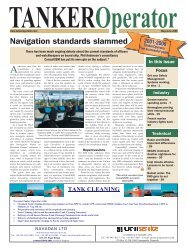Features: - Tanker Operator
Features: - Tanker Operator
Features: - Tanker Operator
Create successful ePaper yourself
Turn your PDF publications into a flip-book with our unique Google optimized e-Paper software.
Celebrating 50 years of service<br />
Voyage Planning Regulatory Advisory Reports and Logs<br />
We are pleased to introduce the<br />
Glosten Ballast Management System<br />
Target Release Date: September 2008<br />
• Software solution for environmental compliance<br />
with ballast management regulations. Designed for<br />
fleet consistency and time savings for crew.<br />
• Easy entry of planned ballast uptake, exchange,<br />
treatment and discharge evolutions by port or tank.<br />
• Immediate compliance feedback based on geographic-<br />
based regulatory database.<br />
• Searchable advisory library of world-wide ballast<br />
management regulations.<br />
• Automated generation of mandatory reports and logs<br />
(e.g. IMO, USCG, Saint Lawrence Seaway, Australia,<br />
California).<br />
• Under Development – Target Release September 2008.<br />
• Contact gbms@glosten.com for more information.<br />
INDUSTRY - FOCUS ON GERMANY<br />
Put to the test. A side section for Seychelles Patriot featuring<br />
perforations. (Photo – Lindenau)<br />
This 189 m long double hull tanker was delivered by the Kiel yard<br />
last February. A three-frame side section of this vessel was built<br />
according to Stehn's design, featuring perforated pre-determined<br />
breaking points. GL is conducting long term measurements on one of<br />
the frames to verify the results of the structural durability calculations<br />
performed thus far.<br />
These measurements were taken using strain gauges attached to the<br />
perforations. These strain gauges consist of plastic strips with etchedon<br />
copper leads. When the material expands, the copper's electrical<br />
resistance will change accordingly. The resistance readings are then<br />
converted into units of tensile force, providing a means to assess the<br />
static and dynamic stresses occurring around the measurement points.<br />
Three perforation holes have been fitted with six strain gauges each.<br />
"Measurements will continue around the clock for an entire year," said<br />
Peter Wania, GL's metrology engineer. "This should provide us with<br />
enough data to answer the question as to whether this design provides<br />
adequate structural durability."<br />
These measurements provide clarity regarding the operational safety<br />
of the design under normal operating loads. "What we cannot do with<br />
these measurements is verify what will happen in a case of collision,"<br />
Tautz conceded.<br />
Therefore, Lindenau will run a series of crash tests, some of which<br />
will involve a scale model of a ship's side, complete with predetermined<br />
breaking points, which will be rammed by a bow-like<br />
element. "We will not be able to substantiate the precise functional<br />
behaviour of our design until we complete the entire research project,"<br />
said Tautz. A three-year window has been assigned for the project.<br />
All parties involved are aware that the new concept will fail in a<br />
worse-case collision scenario, a high speed, right angle impact. "When<br />
a ship collides at a 90 deg angle at high speed, it will cut right through<br />
to the centre of the struck vessel. There is no way to prevent that," said<br />
Stehn. But ships generally heave to when a collision is imminent, so<br />
the impact occurs at an oblique angle. Five to six frames might break<br />
in the process, Stehn estimated, producing an inner-shell dent two to<br />
three metres deep.<br />
The concept of a crumpling zone for tankers may not be ready to be<br />
put into practice immediately. But conceivably, it will shape the way<br />
oil and chemical tankers will be built at Lindenau during the coming<br />
decades. Stehn himself was open to the idea that the patented design<br />
concept of perforated pre-determined breaking points may become an<br />
international requirement at some point in the future.<br />
*This article first appeared in GL’s magazine ‘nonstop’<br />
by whose kind permission this article was reproduced.<br />
TO<br />
TANKER<strong>Operator</strong> � August/September 2008

















